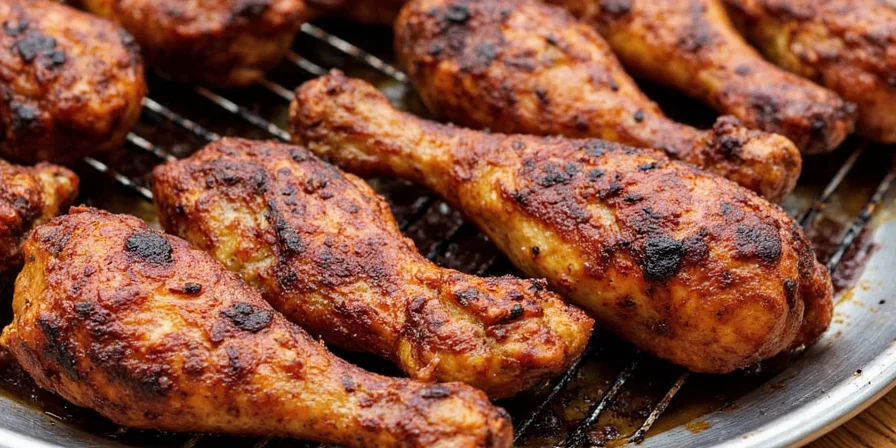Perfect blackened chicken requires three critical elements: completely dry chicken surfaces, a 450-500°F cast iron skillet, and disciplined timing. Skip any of these and you'll get smoke-filled disasters instead of that restaurant-quality charred crust with juicy interior. This guide delivers actionable solutions to the most common blackening failures - no culinary degree required.
Table of Contents
- What Makes True Blackened Chicken (And What Most People Get Wrong)
- The Only Spice Blend You Need (With Heat Adjustments)
- 3 Must-Have Tools (Skip #2 and You'll Fail)
- 7-Step Blackening Process That Actually Works
- Pro Secrets for Zero Smoke Kitchen Results
- Spice Cheat Sheet: What Each Ingredient Actually Does
- 5 Perfect Pairings That Balance the Heat
- 3 Costly Mistakes 90% of Home Cooks Make
- FAQ: Quick Fixes for Common Problems
What Makes True Blackened Chicken (And What Most People Get Wrong)
Blackened chicken isn't burned chicken. It's a precise Cajun technique where spices create a flavorful crust through controlled Maillard reaction at 450-500°F. The biggest myth? That it must create massive smoke. Properly executed blackening produces minimal smoke with maximum flavor - if you follow these fundamentals:
- Dry surface is non-negotiable: Pat chicken with paper towels for 60 seconds
- Cast iron is mandatory: Must maintain 500°F+ temperature
- Oil smoke point matters: Use avocado oil (520°F) not olive oil
The Only Spice Blend You Need (With Heat Adjustments)
This restaurant-proven blend prevents burning while maximizing flavor. Mix in non-reactive bowl:
- 2 tbsp smoked paprika (base)
- 1 tbsp garlic powder
- 1 tbsp onion powder
- 1 tbsp dried thyme
- 1 tbsp dried oregano
- 1 tsp cayenne pepper (adjust for heat)
- 1 tsp freshly ground black pepper
- 1 tsp fine sea salt
- ½ tsp ground mustard (flavor amplifier)
Heat control: Omit cayenne for mild, standard for medium, double cayenne + ½ tsp red pepper for hot. Always mix before application - you can't reduce heat mid-cook.
3 Must-Have Tools (Skip #2 and You'll Fail)
- Pre-seasoned cast iron skillet: Non-stick pans can't maintain required heat
- Instant-read thermometer: Critical for verifying 165°F internal temp without overcooking
- Stove hood fan on high: Run 5 minutes before heating pan to prevent smoke alarms
7-Step Blackening Process That Actually Works
- Dry chicken thoroughly: Press paper towels on all surfaces for 60 seconds (moisture prevents crust)
- Apply spice rub: Press spices firmly into meat; let rest 10 minutes
- Preheat cast iron: 5 minutes on medium-high until water droplets sizzle violently
- Add 1 tbsp oil: Swirl to coat; should shimmer without smoking
- Sear chicken away from you: 3.5 minutes undisturbed until crust forms
- Flip once: Cook 3-4 minutes until internal temp hits 165°F
- Rest 5 minutes: Tent loosely with foil before slicing
Pro Secrets for Zero Smoke Kitchen Results
- Skillet temperature test: Must register 450-500°F (below 400°F creates gray, boiled texture)
- Smoke prevention: Run exhaust fan 5 minutes preheating; keep lid nearby for flare-ups
- Bone-in advantage: Thighs maintain 20% more moisture than breasts
- Perfect adhesion: Lightly brush chicken with oil before spice application
- Batch limitation: Never cook >2 pieces simultaneously to maintain pan temperature
Spice Cheat Sheet: What Each Ingredient Actually Does
| Spice | Flavor Profile | Heat Level | Critical Function |
|---|---|---|---|
| Smoked Paprika | Earthy, sweet, smoky | 0-1,000 Scoville | Creates color base without burning |
| Cayenne Pepper | Sharp, fiery | 30,000-50,000 Scoville | Delivers controlled heat |
| Garlic Powder | Umami-rich, savory | 0 Scoville | Enhances overall flavor depth |
| Dried Thyme | Herbaceous, woodsy | 0 Scoville | Adds aromatic complexity |
| Dried Oregano | Peppery, bold | 0 Scoville | Provides flavor backbone |
| Onion Powder | Deep, rich, sweet | 0 Scoville | Balances acidity |
5 Perfect Pairings That Balance the Heat
- Cold cucumber salad: Vinegar cuts through richness
- Coconut rice: Creaminess neutralizes heat
- Charred citrus slaw: Acidity refreshes palate
- Roasted sweet potatoes: Natural sugars offset smokiness
- Herb-infused aioli: Cooling agent for spice control
3 Costly Mistakes 90% of Home Cooks Make
- Wet chicken surfaces: Causes steaming instead of searing (always dry for 60 seconds)
- Insufficient preheating: Below 400°F creates gray, boiled texture (use infrared thermometer)
- Peeking too soon: Disturbs crust formation before 3-minute mark (chicken releases naturally when ready)
FAQ: Quick Fixes for Common Problems
How do I prevent excessive smoke?
Use avocado oil (520°F smoke point), ensure chicken is completely dry, run exhaust fan 5 minutes before heating pan, and never exceed 500°F surface temperature.
Can I use stainless steel instead of cast iron?
No - stainless steel can't maintain the 450-500°F temperature required. Cast iron's thermal mass is essential for proper char without burning.
Why did my chicken stick to the pan?
Insufficient preheating or premature flipping. Chicken releases naturally when proper crust forms at 3-minute mark. Never force separation.
How do I fix burnt spices?
Reduce skillet temperature to 450°F, use half the cayenne, and ensure chicken is at room temperature before cooking (cold meat drops pan temp).
Can this work for fish?
Reduce cooking time by 40% for delicate fish. Apply half the spice quantity and sear 90 seconds per side at 400°F to prevent burning.











 浙公网安备
33010002000092号
浙公网安备
33010002000092号 浙B2-20120091-4
浙B2-20120091-4